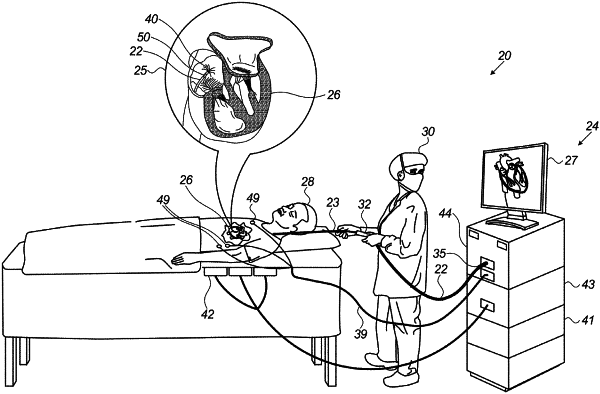| CPC A61B 5/35 (2021.01) [A61B 5/339 (2021.01); A61B 5/36 (2021.01); A61B 5/367 (2021.01); A61B 5/062 (2013.01); A61B 5/287 (2021.01)] | 14 Claims |

|
1. A medical system utilizing automatic pattern acquisition, the system comprising:
respective electrodes configured for application to a body of a subject and configured to output a set of respective activation signals in response to electrical activity of a heart of the subject captured over a sequence of heartbeat intervals; and
a processor configured to:
classify a first heartbeat interval of the set of activation signals as a first morphological template;
for a second heartbeat interval following the first heartbeat interval: compute a measure of similarity between the second heartbeat interval of the set of activation signals and the first morphological template; group the second heartbeat interval of the set of activation signals in a first morphological group with the first morphological template responsively to the measure of similarity exceeding a predefined threshold; and classify the second heartbeat interval of the set of activation signals as a second morphological template responsively to the measure of similarity not exceeding the predefined threshold; and
for a subsequent heartbeat interval: compute a first measure of similarity between the subsequent heartbeat interval of the set of activation signals and at least one of a plurality of previously assigned morphological templates of respective morphological groups, wherein the first measure of similarity between the subsequent heartbeat interval and the at least one of the plurality of previously assigned morphological templates is computed within a moving window of a first duration; if the first measure of similarity is above a first correlation threshold but less than a second correlation threshold, compute a second measure of similarity between the subsequent heartbeat interval of the set of activation signals and at least one of a plurality of previously assigned morphological group within a second a moving window of a second duration greater than the first duration; group the subsequent heartbeat interval of the set of activation signals in one of the morphological groups of one of the previously assigned morphological templates responsively to the measure of similarity with the one previously assigned morphological template exceeding the second threshold; and classify the subsequent heartbeat interval of the set of activation signals as another morphological template responsively to the measure of similarity with the previously assigned morphological templates not exceeding the first threshold.
|